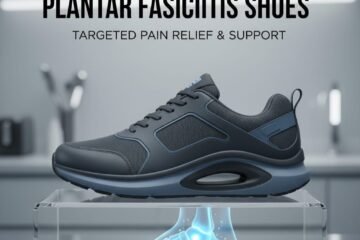🦶 Introduction: Why Footwear Choice Matters
Your feet carry your entire body weight, absorb shocks, and keep you balanced. Yet, most people choose shoes based solely on style or fashion, not on health or support.
This is where medicated shoes come in — designed specifically for foot health, comfort, and medical conditions. But how do they differ from regular shoes? In this guide, we’ll break down the key differences and help you decide which type is right for you.
⚙️ 1. Purpose and Design Philosophy
| Aspect | Medicated Shoes | Regular Shoes |
|---|---|---|
| Purpose | Designed to alleviate pain, prevent injury, and support foot health | Primarily focused on fashion, trends, or casual wear |
| Target Users | People with plantar fasciitis, flat feet, diabetes, arthritis, or foot fatigue | General population without specific medical concerns |
| Design Priority | Ergonomic fit, arch support, cushioning, stability | Aesthetic appeal, trendiness, general comfort |
Key Takeaway: Medicated shoes are engineered for health first, while regular shoes prioritize appearance and general comfort.
🏗️ 2. Arch & Heel Support
- Medicated Shoes: Feature firm arch support, deep heel cups, and motion-control midsoles to correct gait and reduce strain on the plantar fascia.
- Regular Shoes: Often have flat or minimal support, relying on cushioning alone, which may exacerbate foot pain over time.
👣 If you have chronic foot pain, arch support is the most critical difference.
💨 3. Cushioning & Shock Absorption
- Medicated Shoes: Use high-quality EVA foam, memory foam, or gel pads to absorb impact, especially in the heel and forefoot areas.
- Regular Shoes: Cushioning varies widely; many casual shoes provide limited or uneven shock absorption.
Pro Tip: Long-term use of unsupportive shoes can lead to heel spurs, plantar fasciitis, or joint stress.
🌿 4. Materials and Breathability
- Medicated Shoes: Often use breathable, hypoallergenic materials that reduce moisture, irritation, and odor — essential for diabetics or sensitive feet.
- Regular Shoes: May prioritize style over breathability, sometimes using synthetic materials that trap heat.
🦶 Healthy feet require airflow, especially if you wear shoes all day.
🧩 5. Customization and Orthotic Compatibility
- Medicated Shoes: Many feature removable insoles and are compatible with custom orthotics.
- Regular Shoes: Typically have fixed insoles that cannot accommodate orthotics.
Why it matters: Customizable shoes reduce foot pain, prevent deformities, and are essential for chronic conditions.
🩺 6. Safety Features for Medical Conditions
Some medicated shoes are designed for:
- Diabetic foot care: Extra depth to prevent pressure sores
- Arthritis: Extra cushioning and flexibility
- Plantar fasciitis: Targeted heel and arch support
Regular shoes lack these medical-grade features and are not recommended for serious foot conditions.
📊 Comparison Chart: Medicated Shoes vs Regular Shoes
| Feature | Medicated Shoes | Regular Shoes |
|---|---|---|
| Arch Support 🏗️ | Strong, supportive, ergonomic | Minimal or flat |
| Heel Cushioning 💨 | Gel, EVA, or memory foam | Standard foam or minimal |
| Custom Orthotic Compatibility 🧩 | Yes, removable insoles | Usually no |
| Breathable Materials 🌿 | High-quality mesh, leather, hypoallergenic | Varies, often synthetic |
| Safety for Foot Conditions 🩺 | Designed for diabetes, plantar fasciitis, arthritis | None |
| Fashion & Style 🎨 | Moderate, functional | High, trend-focused |
💡 7. Who Should Wear Medicated Shoes?
- Individuals with chronic foot pain
- People with plantar fasciitis, bunions, or flat feet
- Diabetics needing extra protection
- Anyone spending long hours standing or walking
Regular shoes are fine for occasional wear or social events but are not ideal for medical support or long-term foot health.
🦶 8. Cost and Investment
- Medicated Shoes: Typically $100–$250, depending on technology, materials, and brand. Consider it a health investment.
- Regular Shoes: Prices vary widely ($20–$150), often cheaper but less supportive.
Think of medicated shoes as an investment in foot health, preventing medical costs and discomfort in the long run.
🌟 Final Thoughts
Choosing the right shoes is more than a style decision — it’s a health decision.
- Medicated shoes: Prioritize comfort, medical support, and long-term foot health.
- Regular shoes: Focus on fashion and casual comfort, without specialized support.
🦶 If you experience foot pain, plantar fasciitis, or have chronic conditions, medicated shoes are the safer, healthier choice.
👟 Tips for Choosing the Right Medicated Shoes
- Check for arch and heel support.
- Look for removable insoles for orthotics.
- Choose breathable materials.
- Consider condition-specific features (diabetic, plantar fasciitis).
- Prioritize fit and comfort over brand or style.
🌐 Stay Informed
For the latest trends, reviews, and advice on medicated shoes:
Visit medicatedshoes.site


